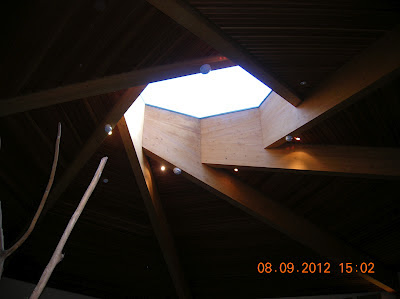Green's Mill on its hill
Picture from: http://www.ilkcam.com/2004/040822/Green's%20Mill.html
After visiting Mottisfont Abbey and Bembridge mill on
the Isle of Wight in September 2009 I blogged the following:
The aristocratic
background of Mottisfont abbey contrasts with the lower class of millers who
understood and operated the mill. Conceptually speaking the mill was a
precursor and symbol of the industrialised world to come. It is ironic that
this lower class of millers were totally unaware that they were dealing with
the basic concepts of mechanism, energy, power and control that were eventually
to dominate the rationale of an industrialized and instrumentalist society. I
was reminded of the fact that my schoolboy introduction to physics was via
pulleys cogs, and levers.
If physics is
fundamental those prosaic looking principles derived from levers, cogs and
pulleys are reckoned to be sufficient to describe the prehistory of the
changing face of our planet.
This passage came to me with special force after my
recent visit to Green’s Mill in Nottingham. George Green (1793-41) started his
life as a miller after inheriting the mill from his father. His lower middle
class status meant that he did not receive a classical education, but in spite
of that he turned out to be a world class self-taught mathematician who went
onto prove Green’s theorem* and develop the Green’s functions. His work has proved
foundational to mathematical physics and his fascinating story can be read in the
book “George Green Miller and Mathematician” .
Largely because of his class recognition came slowly for George Green. In fact
it may be only from the modern perspective, with all that we know today, can we properly
appreciate the value of Green’s work. However, it is to the credit of the upper echelons of British academic society that Green was eventually welcomed into that society on the basis of his work.
Re-quoting myself from the above:
It seems likely that Green himself would probably have been aware of the fundamentals that governed his milling work, but I doubt he would have anticipated just how philosophically dominant they were to become in an industrial world.
Re-quoting myself from the above:
It is ironic that this lower class of millers were totally unaware that they were dealing with the basic concepts of mechanism, energy, power and control that were eventually to dominate the rationale of an industrialized and instrumentalist society.
A highly symbolic picture showing Green's Mill against a back drop of modern industrialisation. Today's industry, needless to say, is rather less "green" than Green's Windmill! Interesting that today we are to some extent returning to the use of the wind.
The visitor's centre at Green's mill celebrates modern science.
Footnote
* Green's theorem is a consequence of Gauss's theorem. The latter integrates flows over a volume and sets it equal to the flow across the boundary of the volume. Greens' theorem does a similar integration but instead does it for circulation vectors, thus arriving at the result that the circulation summed over a volume is equal to the circulation over the surface of the volume.











.jpg)


